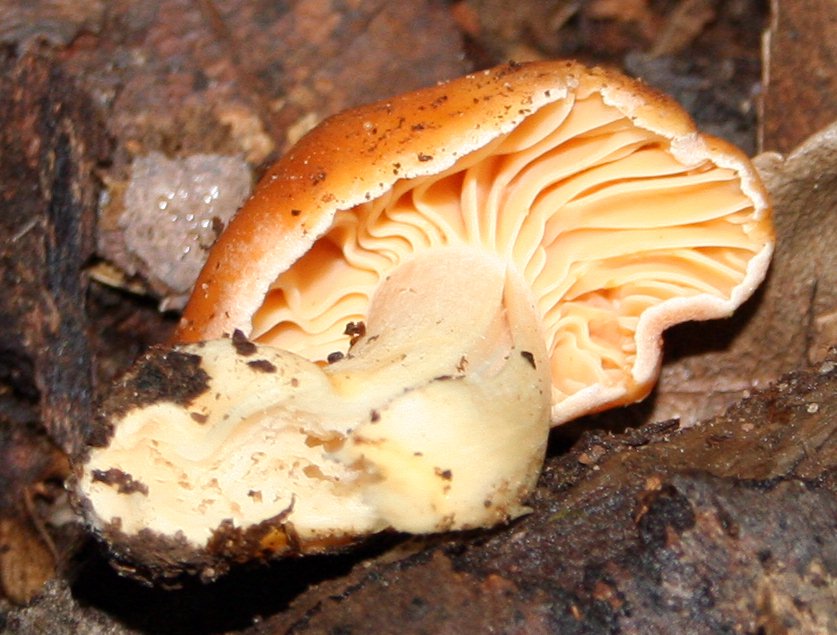- Hygrocybe austropratensis
Taxobox
name = Hygrocybe austropratensis

image_width = 200px
image_caption =
regnum = Fungi
divisio =Basidiomycota
classis =Agaricomycetes
ordo =Agaricales
familia =Hygrophoraceae
genus = "Hygrocybe "
species = "H. austropratensis"
binomial = "Hygrocybe austropratensis"
binomial_authority = A. M. Youngmycomorphbox
name = Hygrocybe austropratensis
whichGills = decurrent
capShape = convex
hymeniumType= gills
stipeCharacter= bare
ecologicalType=saprotrophic
sporePrintColor=white
howEdible=unknown"Hygrocybe austropratensis" is a gilled
fungus of the waxcap family found in a few scattered locations in drysclerophyll forests ineastern Australia . It is a smallmushroom with a 1.4-3 cm diameter pale orange or orange-brown cap and buff-coloured stipe and gills. It is known only fromLane Cove National Park inSydney 's suburban Lower North Shore, Hazelbrook in the Blue Mountains, and Victoria.Taxonomy
"Hygrocybe austropratensis" was originally collected by mycologist Bruce Fuhrer in
Warrandyte State Park inMelbourne 's outer northeastern suburbs onMay 23 1996 , and officially described by Australian mycologist Tony Young in 1999, from a designated holotype collected by Ray and Elma Kearney inLane Cove National Park in Sydney's suburban Lower North Shore district onJune 7 1996 . [cite journal |author=Young AM, Wood AE |year=1999|title=The Hygrocybeae (Fungi, Homobasidiomycetes, Agaricales, Hygrophoraceae) of Lane Cove Bushland Park, New South Wales |journal= Austrobaileya |volume=5 |pages=546] Its specific epithet is made with the prefix "austro-" "southern" onto the existing "pratensis" "of a meadow". [cite book|author = Simpson DP| title = Cassell's Latin Dictionary | publisher = Cassell Ltd.| date = 1979|edition = 5|location = London|pages = 883| isbn=0-304-52257-0]It was separated from the wide-ranging buffcap ("
Hygrocybe pratensis ") by its smaller spores and the fine white fur that covers young mushrooms.Young, p. 68]Description
"Hygrocybe austropratensis" is a small mushroom with a pale orange to orange-brown cap 1.4-3 cm (0.5-1.2 in) in diameter, initially convex and later flattening irregularly. All parts of the mushroom covered with fine white down which disappears with age. The widely-spaced thick gills are decurrent, and occasionally fork at the margin of the cap, and are buff. The buff stipe is 2-4.5 cm (0.8-1.6 in) high and 0.4-0.7 cm thick and may be bulbous at the base. The
spore print is white, the oval spores measuring 7.5 x 6.3 μm.Distribution and habitat
Saprotrophic, this species has been recovered from locations in southeastern Australia including Hazelbrook in the Blue Mountains and Sydney Basin (Lane Cove National Park), and Warrandyte in outer Melbourne. Fruiting bodies appear in autumn and winter (May and June), in leaf litter and mossy areas in dry forest, particularly with "
Kunzea ericoides ", in warm temperate or subtropical climates.It is currently listed by the
Government of New South Wales as "endangered", that is "likely to become extinct unless the circumstances and factors threatening its survival or evolutionary development cease to operate" as defined by the NSW Threatened Species Conservation Act 1995. [cite web |url=http://threatenedspecies.environment.nsw.gov.au/tsprofile/legislation.aspx |title=NSW Threatened Species Legislation |accessdate=2008-04-16 |work=New South Wales Government - Department of Environment and Climate Change website] Searching of suitable habitat has only yielded a very limited occurrence, and its habitat has been deemed vulnerable to waterborne pollution, weed encroachment and damage from pedestrians.cite web |author= NSW Scientific Committee |url=http://www.environment.nsw.gov.au/determinations/HygrocybeAustropratensisEndSpListing.htm |title="Hygrocybe austropratensis" (an agaric fungus) - endangered species listing |accessdate=2008-07-25 |work=New South Wales Government - Department of Environment and Climate Change website]References
Cited text
*cite book | author= Young, A.M. | year =2005 | title = Fungi of Australia: Hygrophoraceae | publisher = (Australian Biological Resources Study) CSIRO, Canberra, ACT | id = ISBN 0-643-09195-5
Wikimedia Foundation. 2010.
